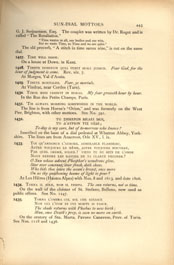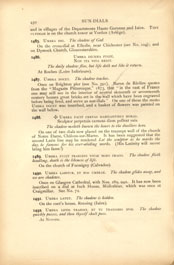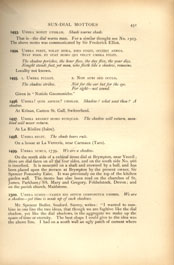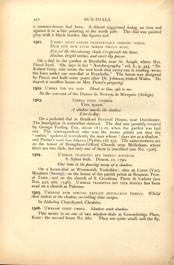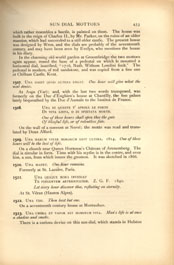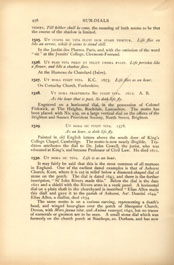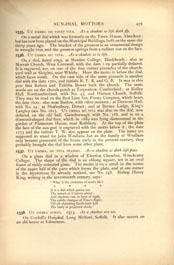Sun-Dial Mottoes (continued.)
| 1417. |
TIME IS, THOU HAST: SEE THAT THOU WELL EMPLOY; Over the door of a schoolmaster's house at Leyburn, Yorkshire. Another version gives the first two lines thus: "Time was, is past: thou canst not it recall; |
| 1418. | TIME PASSETH. Over the church porch at Somersby, co. Lincoln, the parish where Lord Tennyson's father was rector, and where the poet himself was born. |
| 1419. | TIME PASSETH AWAY LIKE A SHADOW. With No. 36 in a garden at Dorking; on Isleworth church, with No. 1631; it is on the porch of East Bergholt church, Suffolk; and can be seen in Constable's picture of the church porch, now in the National Gallery (East Anglian, N.S., 3,136). |
| 1420. |
TIME'S GLASS AND SCYTHE Suggested as a dial motto by Mr. W. Osmond, of Salisbury. |
| 1421. | TIME STEALS AWAY: THE HOUR FLIES: SLOW BUT SURE: I STAY FOR NO MAN. Round the capital of a small pedestal dial in the garden of Buckminster Hall near Grantham. On the dial plate and base of the shaft are other mottoes. See Nos. 443, 1337. |
| 1422. | TIME THE DEVOURER OF ALL THINGS. On a dial made by H. Bon, 1689, seen in a shop in London. |
| 1423. |
TIME TIDE On a dial which originally stood in the garden at Carville Hall, the teaching of the motto being enforced by the position of the house, which stands midway between Newcastle and the sea, overlooking the Tyne. Carville Hall is now the property of J. Wigham Richardson, Esq., and he has presented the dial to the members of the Newcastle |
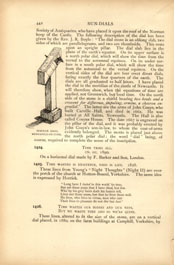
[Full Image]
NORMAN KEEP,
NEWCASTLE-ON-TYNE.
| Society of Antiquaries, who have placed it upon the roof of the Norman keep of the Castle. The following description of the dial has been given by the Rev. J. R. Boyle: "The dial stone is an oblong slab, two sides of which are parallelograms, and two are rhomboids. This rests upon an upright pillar. The dial slab lies in the plane of the earth's equator. On its upper surface is a north polar dial, which will show the time from the vernal to the autumnal equinox. On its under surface is a south polar dial, which will show the time from the autumnal to the vernal equinox. On the vertical sides of the dial are four erect direct dials, facing exactly the four quarters of the earth. The dials are all graduated to half hours. I have placed the dial in the meridian of the castle of Newcastle. It will therefore show, when the equations of time are applied, not Greenwich, but local time. On the north side of the stone is a shield bearing two bends and a crescent for difference, impaling, ermine, a chevron engrailed." The latter are the arms of John Cosyn, who built Carville Hall, and died in 1662. He was buried at All Saints, Newcastle. The Hall is also called Cosyns House. The date 1667 is engraved on the pillar of the dial, and it was probably erected by John Cosyn's son-in-law, to whom the coat-of-arms evidently belonged. The motto is placed just above the north polar dial; the word "dial" being, of course, required to complete the sense of the inscription. | |
| 1424. | TIME TRIES ALL. On a horizontal dial made by F. Barker and Son, London. |
| 1425. | TIME WASTED IS EXISTENCE, USED IS LIFE. 1828. These lines from Young's "Night Thoughts" (Night II) are over the porch of the church at Hutton-Buscel, Yorkshire. The same idea is expressed by Herrick. "Long have I lasted in this world 'tis true, |
| 1426. |
TIME WASTES OUR BODIES AND OUR WITS, These lines, altered to fit the size of the stone, are on a vertical dial placed, in 1880, on the farm buildings at Camphill, Yorkshire, by |
G. J. Serjeantson, Esq. The couplet was written by Dr. Roget and is called "The Retaliation," "Time wastes us all, our bodies and our wits, The old proverb, "A stitch in time saves nine," is cut on the same dial. |
|
| 1427. | TIME WILL SHOW. On a house at Down, in Kent. |
| 1428. | TIMETE DOMINUM QUIA VENIT HORA JUDICII. At Morges, Val d'Aosta.
|
| 1429. | TIMETE MORTALES. Fear, ye mortals. At Vindrac, near Cordes (Tarn). |
| 1430. | TIMOR MIHI CRESCIT IN HORAS. My fear groweth hour by hour. In the Rue des Petits Champs, Paris. |
| 1431. | 'TIS ALWAYS MORNING SOMEWHERE IN THE WORLD. The line is from Horne's "Orion," and was formerly on the West Pier, Brighton, with other mottoes. See No. 391. |
| 1432. |
TO ΣHMEPON MEΛEI MOI, To-day is my care, but of to-morrow who knows? Inscribed on the base of a dial pedestal at Whatton Abbey, Yorkshire. The lines are from Anacreon, Ode XV., 1. ix. |
| 1433. |
At Les Hières (Hautes Alpes) with Nos. 8 and 1613, and date 1806. |
| 1434. | TORNA IL SOLE, NON IL TEMPO. The sun returns, not so time. On the wall of the cloister of St. Stefano, Belluno, now used as public offices. See No. 1247. |
| 1435. |
TORNA L'OMBRA COL SOL CHE RINASCE On the oratory of Sta. Marta, Pavone Canavese, Prov. of Turin. See Nos. 1118 and 1436. |
| 1436. |
TORNA, TORNANDO IL SOL, L'OMBRA SPARITA, These lines are given in "Notizie Gnomoniche," as suitable for a dial motto, and are attributed to Rancati. A dial at Bologna, near the Church of the Misericordia, has a motto almost identical with the above; and another version appears on the Oratory of Sta. Marta, Pavone Canavese, with other mottoes (see Nos. 1118, 1435). A third version was formerly on the Dogana at Isella, on the Italian frontier, but has now disappeared. Compare No. 1098. |
| 1437. | TOT TELA QUOT HORÆ. So many hours, so many darts. On St. Anne's Chapel, near Clermont-en-Argonne, with No. 1516. |
| 1438. | TOTO MICAT ORBE. He shines over the world. Place unknown. "Bull. Mon.," 1877. |
| 1439. | TOUT PASSE. All passeth. In the garden of the Presbytére at Montjoie (Ariège). |
| 1440. | TOUT PASSE ICI BAS. All passeth here below. M. Praderes. Maire. 1830. On the south wall of the Church of Durban (Ariège), beside an old graveyard. The words are nearly obliterated. |
| 1441. |
TOUT PASSE ICI, RIEN NE DEMEURE, At Crépy-en-Valois, with No. 1551. |
| 1442. | TOUTEI MATTRASS0UN, LA DARRIERO ENSUCO. (TOUTES BLESSENT, LA DERNIÉRE ASSOMME.) All wound, the last slays. At Montmeyran, near Varages (Var). |
| 1443. | TRUDITUR DIES DIE. Cezar fecit. 1783. Day by day is thrust aside. From Horace, Carm. II. 18. 15. At Beaurepaire (Isère). |
| 1444. | TRANSEUNT DIES TUI. 1586. Thy days are passing. At Ilminster, on the Grammar School, which is now a girls' school. The date probably refers to the building, rather than to the dial. |
| 1445. | TRANSEUNT ET IMPUTANTUR. 1714. They pass and are reckoned. On the Cistercian abbey of Vallette (Corrèze); and on the Priory of St. Croix near Eu (Seine Inférieure). |
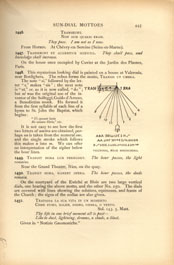
[Full Image]
VALCROSIA,
NEAR BORDIGHERA.
| 1446. |
TRANSEUNT. They pass. I am not as I was. From Horace. At Chévry-en-Sereine (Seine-et-Marne). |
| 1447. | TRANSIBUNT ET AUGEBITUR SCIENTIA. They shall pass, and knowledge shall increase. On the house once occupied by Cuvier at the Jardin des Plantes, Paris. |
| 1448. | This mysterious looking dial is painted on a house at Valcrosia, near Bordighera. The rebus forms the motto, TRANSIS UT UMBRA. The note "si" followed by the letter "s" makes "sis"; the next note is "ut," or, as it is now called, "do"; but ut was the original use of the inventor of the Solfeggi, Guido d'Arezzo, a Benedictine monk. He formed it from the first syllable of each line of a hymn to St. John the Baptist, which begins: "Ut queant laxis It is not easy to see how the first two letters of umbra are obtained, perhaps un is taken from the numeral one, and the single stroke which follows this makes n into m. We can offer no interpretation of the cipher below the hour lines. |
| 1449. | TRANSIT HORA LUX PERMANET. The hour passes, the light remains. Near the Grand Theatre, Nice, on the quay. |
| 1450. | TRANSIT HORA, MANENT OPERA. The hour passes, the deeds remain. On the courtyard of the Evêché at Blois are two large vertical dials, one bearing the above motto, and the other No. 250. The dials are covered with lines showing the solstices, equinoxes, and feasts of the Church; the signs of the zodiac are also given. |
| 1451. |
TRAPASSA LA SUA VITA IN UN MOMENTO Given in "Notizie Gnomoniche." |
| 1452. | TRAVAILLEZ, CAR LE TEMPS S'ENFUIT. Work, for time flies. At Le Bez (Hautes Alpes), on a dial made by Zarbula, about 1860. |
| 1453. | TPEXEI A'ΠAϒΣTOΣ. It runs without stopping. On the wall of an inn at Izeaux (Isère). |
| 1454. | TRIFLE NOT, YOUR TIME'S SHORT. 1775. At Milton, near Gravesend. So says Sir Walter Scott: "Nay, dally not with Time, the wise man's treasure, |
| 1455. | TRISTIS ERAT SINE SOLE DOMUS. Sad was the house without the sun. At Montauban (Tarn et Garonne). |
| 1456. |
TRUE AS THE DIAL TO THE SUN The lines are from Hudibras, and the dial is on the south aisle of Halifax Church, Yorkshire. The names of William Roberts, John Illingworth, Robert Abbott, and John Sutcliffe, churchwardens, are inscribed upon it. Another dial, probably older than this one, crowns the gable of the south porch. |
| 1457. |
TU AVANCE A GRADE PAS VERS L'HEURE DE Thou advancest with rapid strides towards the hour of thy death, my needle points out both heaven and earth, it is for thee to think upon them. On the church of St. Nicolas du Tertre (Morbihan). |
| 1458. | TU LES COMPTES, ELLES FUIENT. 1569. 1692. 1857. Thou countest them, they fly. At Virieu (Isère). The two latter dates are those of the renewal of the dial. |
| 1459. | TU NUMERI L'ORE MA NON SAI L' ORA DELLA MORTE. Thou countest the hours, but thou knowest not the hour of death. At Vigo, near Pinzola. |
| 1460. |
TU, QUAMCUNQUE DEUS TIBI FORTUNAVERIT HORAM, Whatever happy hour Providence has allotted thee, grasp it with grateful hand, and put not off its pleasures till the coming (next) year. |
From Horace's Epistles, Bk. I., Ep. XI., lines 22, 23, and inscribed on the eastern face of a double dial on the Château de Preuilly (Seine et Marne). On the west is No. 1191. |
|
| 1461. |
TU SEMPRE E QUANDO MUORI, E QUANDO NASCI, Given in "Notizie Gnomoniche." |
| 1462. |
TU SORTIRAS QUAND CE CADRAN Thou shall go forth when this dial shall show the hour and the moment. It is stated in Delaure's "History of Paris" that the above lines were inscribed by one Charnel of Châlons, above a dial which he traced on the wall of his prison in the Bastille, and adorned with a Death's head and cross bones. |
| 1463. | TUA HORA RUIT MEA. The hour which is mine, destroys what is thine. In the cloister of the old Franciscan convent at Cimiez, near Nice (see No. 233). The Latin of the motto is monkish; ruo is treated as an active verb, and the dial, as usual, is supposed to speak. |
| 1464. | TUA LATET. Thine (hour) is hidden. On the church of Cahahons (Pyrenées Orientales), which was once a hermitage. |
| 1465. | TVAM NESCIS. Thou knowest not thine (hour). On a house in Palermo; and also on the cathedral clock at Monreale. |
| 1466. |
TVVS EST DIES, ET TVA EST NOX, On a vertical dial on Maxey Vicarage, Northamptonshire, erected by the Rev. W. D. Sweeting. His initials, W. D. S., are on the stone, while the date, 1881, forms part of the copper support of the gnomon, so that the figures can be read backwards or forwards, and both in the morning and the afternoon the shadow gives the date of the erection of the dial. |
| 1467. | TURRIS MEA DEUS. God is my stronghold. At the Château de Virieu (Isère). |
| 1468. | TUTTE LE COSE PERISCONO, IO SONO IMMORTALE. All things perish, I am immortal. At Diano Castello, on the Riviera. |
| 1469. |
TYME PASSETH AND SPEKETH NOT, The above lines are inscribed round the four sides of a very beautiful old dial pillar at Moccas Court, Herefordshire. The dial belongs to the lectern-shaped class, and bears dials of various shapes in cup-like hollows, heart shaped, triangular, square, besides others on plain surfaces (see Chapter VI, p. 99). Between and around them five other mottoes are carved, Nos. 131, 217, 512, 1151, 1230. On the north side, beneath the signs of the planets, is "Domus Planetarum Philippus Jones." The dial which now belongs to the Rev. Sir George Cornewall, Bart, is thought to have been made in the reign of Charles II., and was first set up at Mornington Court (on the opposite side of the Wye), the property of the Tompkins family. When this property came into the possession of the Cornewalls, the dial was brought to Moccas. |
| 1470. | TYME TRYETH TROTHE. On a dial in the village of Cradley, near Malvern; and also on an old dial plate mounted on an embossed draining tile at Oatlands Park, Surrey. |
| 1471. | VBI. VMBRA. CADIT. 1803. When the shadow falls. At Betenoud (Isère), round the gnomon. A second motto – LE CIEL EST MA REGLE is also on the dial. |
| 1472. | ULTIMA DECIDIT. 1848. B. A. F. The last (hour) will determine. On a house at Ventimiglia. |
| 1473. | ULTIMA FORSAN. Perhaps the last (hour). Seen in Switzerland on a house; and also in the Piazza S. Domenico, Bologna; and at St. Rémy (Bouches du Rhône). |
| 1474. | ULTIMA FORTE TIBI. Perchance it is thy last hour. At La Rivière (Isère). |
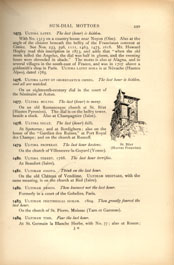
[Full Image]
ST. BÉAT,
(HAUTE PYRENÉES).
| 1475. | ULTIMA LATET. The last (hour) is hidden. With No. 1313 on a country house near Noyon (Oise). Also at the angle of the cloister beneath the belfry of the Franciscan convent at Cimiez. See Nos. 233, , 1111, 1463, 1475, 1618. Mr. Howard Hopley read this inscription in 1873, and adds that "when the old monk tolled the Angelus, the dial was half in gloom, and the evening hours were shrouded in shade." The motto is also at Alagna, and in several villages in the south-east of France, and was in 1707 above a goldsmith's shop in Paris. ULTIMA LATET HORA is at Névache (Hautes Alpes), dated 1785. |
| 1476. | ULTIMA LATET ET OBSERVANTUR OMNES. The last hour is hidden, and all are watched. On an eighteenth-century dial in the court of the Séminaire at Autun. |
| 1477. | ULTIMA MULTIS. The last (hour) to many. On an old Romanesque church at St. Béat (Hautes Pyrenées). The dial is on the belfry tower, beside a clock. Also at Champagnier (Isère). |
| 1478. | ULTIMA NECAT. The last (hour) kills. At Spotorno; and at Bordighera; also on the house of the "Gardien des Ruines," at Port Royal des Champs; and on the church at Roscoff. |
| 1479. | ULTIMA PROPERAT. The last hour hastens. On the church of Villeneuve-la-Guyard (Yonne). |
| 1480. | ULTIMA TERRET. 1768. The last hour terrifies. At Beaufort (Isère). |
| 1481. | ULTIMAM COGITA. Think on the last hour. On the old Château of Vendôme. ULTIMAM MEDITARE, with the same meaning, is on the church at Biol (Isère). |
| 1482. | ULTIMAM NESCIS. Thou knowest not the last hour. Formerly in a court of the Gobelins, Paris. |
| 1483. | ULTIMAM PERTIMESCAS HORAM. 1804. Thou greatly fearest the last hour. On the church of St. Pierre, Moissac (Tarn et Garonne). |
| 1484. | ULTIMAM TIME. Fear the last hour. At St. Germain la Blanche Herbe, with No. 77; also at Rouen; |
| and in villages of the Departments Haute Garonne and Isère. TIME ULTIMAM is on the church tower at Verdun (Ariège). | |
| 1485. | UMBRA DEI. The shadow of God. On the cross-dial at Elleslie, near Chichester (see No. 104); and on Dymock Church, Gloucestershire. |
| 1486. |
UMBRA DIURNA FUGIT, The daily shadow flies, but life doth not like it return. At Roches (Loire Inférieure). |
| 1487. | UMBRA DOCET. The shadow teaches. Once on Brighton pier (see No. 391). Baron de Rivière quotes from the "Magazin Pittoresque," 1873, that "in the east of France one may still see in the interior of several sixteenth or seventeenth century houses great bricks set in the wall which have been engraved before being fired, and serve as sun-dials." On one of these the motto UMBRA DOCET was inscribed, and a basket of flowers was painted on the wall below. |
| 1488. |
✠ UMBRA FACIT CERTAS HABITANTIBUS HORAS. The shadow maketh known the hours to the dwellers here. On one of two dials now placed on the transept wall of the church of Notre Dame, Châlons-sur-Marne. It has been suggested that the second Latin line may be rendered Let the sculptor as he marks the day, be famous for his ever-abiding works. (His Latinity will never bring him fame!) |
| 1489. | UMBRA FUGIT PRAECEPS VITAE MORS IMAGO. The shadow flieth headlong, death is the likeness of life. On the church of Formigny (Calvados). |
| 1490. | UMBRA LABITUR, ET NOS UMBRAE. The shadow glides away, and we are shadows. Once on Glasgow Cathedral, with Nos. 289, 942. It has now been inscribed on a dial at Inch House, Midlothian, which was once at Craigmillar. See No. 72. |
| 1491. | UMBRA LATET. The shadow is hidden. On the curé's house, Recoing (Isère). |
| 1492. | UMBRA LEVIS TRANSIT, ET TU TRANSIBIS IPSE. The shadow guickly passes, and thou thyself shalt pass. At Nevers. |
| 1493. | UMBRA MONET UMBRAM. Shade warns shade. That is – the dial warns man. For a similar thought see No. 1503. The above motto was communicated by Sir Frederick Elliot. |
||||||
| 1494. |
Locality not known. |
||||||
| 1495. |
Given in "Notizie Gnomoniche." |
||||||
| 1496. | UMBRA! QUID ASPICIS? UMBRAM. Shadow! what seest thou? A shadow. At Krinan, Canton St. Gall, Switzerland. |
||||||
| 1497. | UMBRA REDIBIT HOMO NUNQUAM. The shadow will return, mankind will never return. At La Rivière (Isère). |
||||||
| 1498. | UMBRA REGIT. The shade bears rule. On a house at La Verrerie, near Carmaux (Tarn). |
||||||
| 1499. | UMBRA SUMUS, 1739. We are a shadow. On the north side of a cubical stone dial at Brympton, near Yeovil; there are dial-faces on all the four sides, and on the south side No. 966 is inscribed. It is mounted on a shaft and crowned by a ball, and has been placed upon the terrace at Brympton by the present owner, Sir Spencer Ponsonby Fane. It was previously on the top of the kitchen garden wall. The motto has also been read on the churches of St. James, Parkham; SS. Mary and Gregory, Frithelstock, Devon; and on the parish church, Maidstone. |
||||||
| 1500. | UMBRA SUMUS – TAMEN HIS AEVUM COMPONITUR UMBRIS. We are a shadow – yet time is made up of such shadows. Mr. Spencer Butler, Seaford, Surrey, writes: "I wanted to combine in one line the two ideas, that though we are fugitive like the dial shadow, yet like the dial shadows, in the aggregate we make up the space of time or eternity. The best shape I could give to the idea was the above line. I had on a south wall an ugly patch of cement where |
| a summer-house had been. A friend suggested fixing an iron rod against it in a line pointing to the north pole. The dial was painted grey with a black border, the figures red. | |
| 1501. |
UMBRA TEGIT LAPSAS PRAESENTIQUE IMMINET HORAE, On a dial in the garden at Brynbella, near St. Asaph, where Mrs. Piozzi lived. She says in her "Autobiography," vol. ii., p. 345, "Dr. Robert Gray, who wrote the new book that every one is reading, wrote the lines under our sun-dial at Brynbella." The house was designed by Piozzi, and built some years after Dr. Johnson visited Wales. He stayed at another house on Mrs. Piozzi's property. |
| 1502. | UMBRA TIBI SOL MIHI. Shade to thee, sun to me. At the convent of the Dames de Nevers, at Mirepoix. (Ariège). |
| 1503. |
UMBRA VIDET UMBRAM On a pedestal dial at Bradford Peverell House, near Dorchester. The inscription is somewhat defaced. The dial was possibly erected by George Purling, Esq., about 1815-20, when the garden was laid out. The correspondent who sent the motto points out that the "umbra" spoken of is evidently the man whose "days are as a shadow," and Pindar's σκιᾶς ὄναρ ἄνθρωπος (Pythia, viii. 95). The same mottoes are on the tower of Broughton-Gifford Church, near Melksham, where there are two dials, but only one of them is inscribed (see No. 1506). |
| 1504. |
UMBRAE TRANSITUS EST TEMPUS NOSTRUM. On a house-dial at Wentworth, Yorkshire; also at Cuers (Var), Moutiers (Savoy); on the house of the parish priest at Bousson, Prov. of Turin; and on the church of S. Crocifisso, Pieve di Cadore (see Nos. 442, 966, 1548). UMBRAE TRANSITUS EST VITA NOSTRA has been read on a church at Palermo. |
| 1505. | UMBRAM DUM SPECTAS REFUGIT REVOLUBILE TEMPUS. Whilst thou lookest at the shadow, on-rolling time escapes. In Alderley Churchyard, Cheshire. |
| 1506. | UMBRAM VIDET UMBRA. Shadow seeth shadow. This motto is on one of two window-dials at Groombridge Place, Kent; the second bears No. 682. They are quite small, and the fly, |
which rather resembles a beetle, is painted on them. The house was built in the reign of Charles II., by Mr. Packer, on the ruins of an older mansion, which had succeeded to a still older castle. The present house was designed by Wren, and the dials are probably of the seventeenth century, and may have been seen by Evelyn, who mentions the house in his diary. In the charming old-world garden at Groombridge the two mottoes again appear, round the base of a pedestal on which is mounted a horizontal dial, inscribed, "1716, Nath. Witham Londini fecit." The pedestal is modern, of red sandstone, and was copied from a fine one at Chilham Castle, Kent. |
|
| 1507. | UNA DABIT QUOD ALTERA NEGAT. One hour will give what the next denies. At Aups (Var); and, with the last two words transposed, was formerly on the Duc d'Enghien's house at Chantilly, the fine palace lately bequeathed by the Duc d'Aumale to the Institut de France. |
| 1508. |
UNA DI QUESTE T' APRIRA LE PORTE On the wall of a convent at Nervi; the motto was read and translated by Dean Alford. |
| 1509. | UNA HARUM VITAE HORARUM ERIT ULTIMA. 1814. One of these hours will be the last of life. On a church near Queen Hortense's Château of Arenemberg. The dial is circular in form. Time with his scythe is in the centre, and over him, a sun, from which issues the gnomon. It was sketched in 1866. |
| 1510. | UNA MANET. One hour remains. Formerly at St. Lazaire, Paris. |
| 1511. |
At St. Véran (Hautes Alpes). |
| 1512. | UNA TIBI. Thou hast but one. On a seventeenth century house at Montauban. |
| 1513. | UNA UMBRA ET VAPOR EST HOMINUM VITA. Man's life is at once a shadow and smoke. There is a curious device on this sun-dial, which stands in Helston |
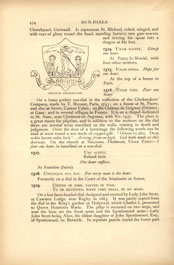
[Full Image]
HELSTON CHURCHYARD.
| Churchyard, Cornwall. It represents St. Michael, robed, winged, and with rays of glory round the head, standing betwixt two gate-towers, and driving his spear into a dragon at his feet. | |
| 1514. | UNAM RAPITE. Grasp one hour. At Paray-le-Monial, with four other mottoes. |
| 1515. | UNAM SPERA. Hope for one hour. At the top of a house in Paris. |
| 1516. | UNAM TIME. Fear one hour. On a brass pocket sun-dial in the collection of the Clockmakers' Company, made by T. Menant, Paris, 1743; on a house at St. Pierre, and also at Sierre, Canton Valais; on the Château de Grignan (Drôme); at Gass; and in several villages in France. It is on a chapel dedicated to St. Anne, near Clermont-en-Argonne, with No. 1437. The place is a great resort for pilgrims, and in addition to the mottoes on the dial there are several texts inscribed on the walls, relating to death and judgment. Over the door of a hermitage the following words can be read at noon round a sun made of copper-gilt: "Oriens ex alto. Deus nobis hæcce ostia fecit" – Arising from on high. God hath made us this doorway. On the church at Stazzano, Piedmont, UNAM TIMEO – I fear one hour, is inscribed on a sun-dial. |
| 1517. |
UNE SUFFIT. At Arandon (Isère). |
| 1518. | UNICUIQUE SUA EST. For every man is his hour. Formerly on a dial in the Court of the Séminaire at Autun. |
| 1519. |
UNITED IN TIME, PARTED IN TIME, On a fine facet-headed dial, designed and erected by Lady John Scott, at Cawston Lodge, near Rugby, in 1863. It was partly copied from the dial in the King's garden at Holyrood, which Charles I. presented to Queen Henrietta Maria. The pillar is mounted on two steps, and near the base are the Scott arms and the Spottiswood arms – Lady John Scott being Alice, the eldest daughter of John Spottiswood, Esq., of Spottiswood, co. Berwick. In separate panels round the lower part |
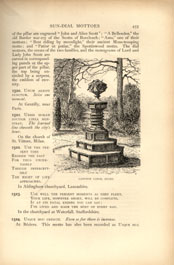
[Full Image]
CAWSTON LODGE, RUGBY.
| of the pillar are engraved "John and Alice Scott"; "A Bellenden," the old Border war-cry of the Scotts of Buccleuch; "Amo," one of their mottoes; "Best riding by moonlight," their ancient Moss-trooping motto; and "Patior ut potiar," the Spottiswood motto. The dial mottoes, the crests of the two families, and the monograms of Lord and Lady John Scott are carved in corresponding panels at the upper part of the pillar, the top being encircled by a serpent, the emblem of eternity. | |
| 1520. | UNUM ARRIPE PUNCTUM. Seize one moment. At Gentilly, near Paris. |
| 1521. | URBIS HORAM DOCTIOR LINEA MONSTRAT. The learned line showeth the city's hour. On the church of St. Vittore, Milan. |
| 1522. |
USE THE PRESENT TIME In Aldingham churchyard, Lancashire. |
| 1523. |
USE WELL THE PRESENT MOMENTS AS THEY FLEET, In the churchyard at Waterfall, Staffordshire. |
| 1524. | USQUE HUC CRESCIT. Even so far there is increase. At Béziers. This motto has also been recorded as USQUE HUC |
| VENIET, Till hither shall he come, the meaning of both seems to be that the course of the shadow is limited. | |
| 1525. | UT CUSPIS SIC VITA FLUIT DUM STARE VIDETUR. Life flies on like an arrow, while it seems to stand still. In the Jardin des Plantes, Paris, and, with the omission of the word "sic" at the Jesuits' College, Clermont-Ferrand. |
| 1526. | UT FLOS VITA PERIT ET VELUT UMBRA FUGIT. Life perishes like a flower, and like a shadow flees. At the Hameau du Chatelard (Isère). |
| 1527. | UT HORA FUGIT VITA. K.C. 1675. Life flies as an hour. On Cortachy Church, Forfarshire. |
| 1528. |
VT HORA PRAETERITA SIC FUGIT VITA. 1612. A. B. Engraved on a horizontal dial, in the possession of Colonel Fishwick, at The Heights, Rochdale. Lancashire. The motto has been placed, with No. 939, on a large vertical dial on the offices of the Brighton and Sussex Provident Society, North Street, Brighton. |
| 1529. |
UT HORA SIC FUGIT VITA. 1578. Painted in old English letters above the south door of King's College Chapel, Cambridge. The motto is now nearly illegible. Tradition attributes the dial to Dr. John Cowell, the jurist, who was educated at King's, and became Professor of Civil Law. He died 1611. |
| 1530. | UT HORA SIC VITA. Life is as an hour. It may fairly be said that this is the most common of all mottoes in England. One of the earliest dated examples is that of Ashurst Church, Kent, where it is cut in relief below a diamond-shaped dial of stone on the porch. The dial is dated 1643, and there is the further inscription, "Sir Iohn Rivers made this." Below the dial is the date 1621 and a shield with the Rivers arms in a sunk panel. A horizontal dial on a plain shaft in the churchyard is inscribed "Elias Allen made this diall and gave it to the parish of Ashurst, Ano. Domini 1644." Elias Allen, a diallist, died 1654. The same motto is on a curious carving, representing a death's head, and winged hour-glass over the porch of Sheepstor Church, Devon, with Mors janua vitæ and Anima resurget, 1640, but no traces of numerals or gnomon are to be seen. A small stone dial which was formerly on the church porch at Stanhope, co. Durham, and has now |
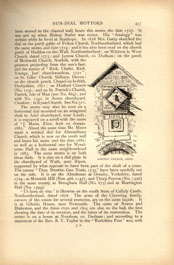
[Full Image]
ASHURST CHURCH, KENT.
been moved to the chancel wall, bears this motto, the date 1727. It was put up when Bishop Butler was rector. His "Analogy" was written while he lived at Stanhope. In 1828 Mrs. Gatty sketched the dial on the porch gable of Felton Church, Northumberland, which had the same motto, and date 1724; and it has also been read on the church porch of Heddon-on-the-Wall, Northumberland; on Whitton le Wear Church, dated 1773; and Jarrow Church, co. Durham; on the porch of Methwold Church, Norfolk, with the gnomon projecting from the sun's face, and the names of "Rich. Clarke, Rich. Younge, Junr. churchwardens, 1721"; on St. Giles' Church, Sidbury, Devon; on the church porch, Chapel-en-le-frith, Derbyshire, 1871; on Hatford Church (No. 123); and on St. Patrick's Church, Patrick, Isle of Man (see No. 864); and with No. 1342, in Acton churchyard, Cheshire; in Eyam Church. See No. 511. The motto may also be seen on a horizontal dial mounted on an octagonal shaft in Adel churchyard, near Leeds; it is engraved on a scroll with the name of "J. Munn, Ebor. fecit ex donatu. 1682." About the same time Mr. Munn made a vertical dial for Almondbury Church, which is now on the south wall and bears his name and the date 1682; as well as a horizontal one for Woodsome Hall in the same neighbourhood in 1683. The same motto is on both these dials. It is also on a dial-plate in the churchyard of Wath, near Ripon, supported by what appears to have been part of the shaft of a cross. The names "Thos. Browne, Geo. Yeats, 1735" have been carefully cut on the side. It is on the Almshouse at Ormsby, Yorkshire, dated 1724; at Menwith Hill (Nos. 468, 1147); and Thorp Perrow (No. 1396) in the same county, at Brougham Hall (No. 875) and at Marrington Hall (No. 1394). "Ut hora sic vita" is likewise on the south front of Callaly Castle, Northumberland, dated 1676. The arms of the Clavering family, owners of the estate for several centuries, are on the same façade. It is at Gibside House, near Newcastle. The arms of Bowes and Blakeston, and the dates 1620 and 1805 are also on the hall, the first showing the date of its erection, and the latter of its restoration. The motto is on a house at Neasham, co. Durham; and according to a statement of the Rev. R. V. Taylor in the "Yorkshire Post" was, with |
date 1672, upon a dial which formerly stood at Wooldale, near Holmfirth, in front of an old house. The plate was fastened upon a curious pillar of rudely hewn stones, which bore some resemblance to a house clock and was known by the name of "Old Genu's dial," or "Genu's clock." An engraving of it is in Morehouse's "History of Kirkburton." The pillar has been removed and the dial erected on the wall of an outbuilding. It bears the initials H. G. and S. H., supposed to be those of the sculptor and the owner. The same words are engraved on a horizontal dial dated 1630, which came from an old garden at Dereham, in Norfolk. The gnomon is pierced with the initials I. S., probably those of the first owner. The dial is now placed on an oak post in the garden of Woodburn, Crowborough. The motto appears to have been a favourite one in the Isle of Man, for it is found on a thin slate dial face now in Mr. Wallace's museum at Distington, near Whitehaven, but which there is reason to believe once belonged to Sautan Church, Isle of Man; and also on a bronze dial plate found on a rubbish heap near the Albert Brewery at Ramsey, and which in 1889 was in the possession of a tailor in Ramsey named Corkhill. Lastly, "Ut hora sic vita" is inscribed on the clock which was placed in 1859 on the tower of Hoole Church, Lancashire, as a memorial of Jeremiah Horrox, who discovered the transit of Venus when he was curate at Hoole in 1639. |
|
| 1531. | UT JUGULENT HOMINES, SURGUNT DE NOCTE LATRONES. Robbers arise at night to murder men. From Horace, Epistles I., ii. 32, on a dial at the entrance of a wood. |
| 1532. | UT RUIT UNDA FUGAX SIC NOSTRA ILLABITUR AETAS. At the Séminaire, Vesoul. |
| 1533. |
VT SOL ITA MVNDVS On a beautifully engraved horizontal dial plate belonging to the Duke of Sutherland, and placed on a pedestal at Lilleshall Manor, Salop. The arms of "Leuison" and "Duddeley" (which names are inscribed above the shield) with their crests, one of which is the historic Bear with the ragged staff, are also on the plate, which is square though the dial is circular. The corners are filled with finely engraved designs, and there is the further inscription: "Restored 1896 by F. Barker, London." |
| 1534. | UT UMBRA DECLINAVERUNT. They have gone down as a shadow. At Trafiume, near Cannobio, Lago Maggiore. |
| 1535. | UT UMBRA SIC FUGIT VITA. As a shadow so life doth fly. On a metal dial which was formerly on the Town House, Aberdeen; but has now been placed on the Municipal Buildings, built on the same site thirty years ago. The bracket of the gnomon is an ornamental design in wrought iron, and the gnomon springs from a radiant sun on the face. |
| 1536. | UT UMBRA SIC VITA. As a shadow so is life. On a dial, dated 1695, at Morden College, Blackheath; also at Morvah Church, West Cornwall, with the date I-29 partially defaced. It is engraved, too, on one of the four corner pinnacles of the churchyard wall at Sleights, near Whitby. Here the motto is below the dial, which faces south. On the east side of the same pinnacle is another dial with the date 1761, and initials R. T. B. and G. B. It was in this year that Robert and Tabitha Bower built the church. The same words are on the church porch at Torpenhow, Cumberland; at Ridley Hall, Northumberland, with No. 45, and Hartest Church, Suffolk. They may be read on the Red Lion Inn, Fenny Compton, which bears the date 1600; also near Baslow, with other mottoes; at Derwent Hall, with No. 24; at Shaftesbury, Dorset; and at Barnes Lodge, King's Langley (see No. 161). UT UMBRA SIC VITA was also on the dial, now defaced, on the old hall, Gainsborough, with No. 188, and is on a diamond-shaped dial face, which in 1889 was lying dismounted in the garden of Flotterton House, near Rothbury. At the top of the plate the face of the sun-god is engraved with the motto below it; the date 1773 and the initials T. W. also appear on the plate. The latter are supposed to stand for John Weallans, but as the family of Weallans only became possessed of the house early in the present century, they probably brought the dial from some other place. |
| 1537. | UT UMBRA, SIC VITA TRANSIT. As a shadow so doth life pass. On a glass dial in a window of Election Chamber, Winchester College. The shape of the dial is an oblong square, set in an oval frame of richly-coloured glass. The motto is on a scroll in the centre of the upper half of the pane which forms the plate, and at one corner is the mysterious fly already noticed, see No. 248. Bishop Henry King, writing in the seventeenth century, says: "What is the existence of man's life? |
| 1538. | UT UMBRA SUMUS. 1573. As a shadow are we. On Cordell's Hospital, Long Melford, Suffolk. It also occurs on an old house at Edmonton. |
| 1539. | UT VITA FINIS ITA. 1652. As the life is so is its end. On the tower of Chelsea Old Church. The dial has lately been repaired, and also the brick tower. Sir Thomas More lies buried in the church. |
| 1540. | UT VITA SIC FUGIT HORA. The hour passes away like life. On the second chapel of the Sacro Monte at Orta: and on a large diagram of a sun dial in "Rudimenta Mathematica," by Sebastian Münster (Basle, 1551). |
| 1541. | UT VITA SIC UMBRA. As life so is the shadow. On a house at Kirby Moorside, dated 1833: on one of the dial faces at Thorp Perrow, Yorkshire (see No. 1396); and at Elleslie, Chichester (see No. 104). |
| 1542. | UTERE DUM LABITUR. Employ it while it glides on. At Les Tilleuls, near Perpignan. |
| 1543. | UTERE DUM LYCET (sic). Use it while it (time) is given. Formeriy on a dépendance of the Convent de la Merci, Paris, but this no longer exists. Compare No. 240. |
| 1544. | UTERE DUM NUMERAS. Employ, while thou countest them. No locality assigned. |
| 1545. | UTERE, FUGIT. Use it, it flies. At La Roquette, near Castelnaudary (Aude). |
| 1546. | UTERE NON NUMERA. 1809. Employ them, count them not. At St. Foy (Savoy). |
| 1547. | UTERE NON REDIT HORA. Employ the hour, it returneth not. On the Quai des Théatins, Paris, in 1787. |
| 1548. | UTERE PRAESENTI MEMOR ULTIMAE. Use the present hour, mindful of the last. On the Church of S. Crocifisso, Pieve di Cadore, see No. 442; at Strevi; on the Lycée, formerly a Jesuit college, at Montpellier: and at St. Blaise du Bois (Isère), dated 1786. The first two words, with "D. C. S. 1784" are in the garden of the Hôtel de Rochegarde, Albi (Tarn); at the Grand Séminaire at Aix in Provence; and in the garden of the Hospital of St. Jacques at Besançon, with other mottoes. See No. 75. |
| 1549. | UTERE PRAESENTI NAM VELUT UMBRA, TEMPUS FUGIT. Employ the present time, for like a shadow, it flees. At Nevers. |

